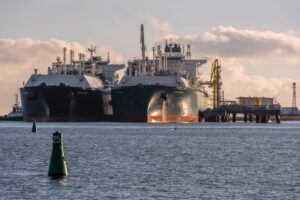How much do the supplies of liquefied gas from the USA, which is to be delivered by British Centrica, to Poland cost? We can only estimate it, but previously published estimations can be questioned right away. Below I present a short analysis on this subject enriched with humorous elements for the reader’s good that passed new high school diploma exams – writes Wojciech Jakóbik, editor-in-chief of BiznesAlert.pl.
Business or politics?
Russian media and their echoing entities in Poland tell the story that LNG from the USA flows to Poland under an unprofitable political agreement. There are attempts to present the contract as unattractive in terms of price. On the other hand, we can read the texts which show that the price can be attractive, and I think that it can be possible. However, if the PGNiG-Centrica agreement uses a revolutionary (and, in fact, simply a market) formula that can change the game state in the region after 2022, the critics’ argumentation is incorrect.
The unrivaled Andrzej Szczęśniak has consistently criticized the policy of diversifying supplies sources to Poland. He recalls that in August 2017, PGNiG reserved all the available capacity of gas terminal. In his opinion this direction is unprofitable, because it is permanently less competitive in relation to gas pipelines supplies from Russia, Norway and Africa. Despite this, he does not praise the idea of building the Baltic Pipe, which would provide Norwegian gas from the pipe, in his opinion competitive – let him forgive me this sarcasm.
Szczęśniak quotes Krzysztof Szczerski, who taking the office of the advisor to the President of the Republic of Poland, Andrzej Duda, argued that the spot delivery from Cheniere Energy in June 2017 was the effect of the president’s talks with his American counterpart, Donald Trump. Meanwhile, they took place during the July meeting of the Three Seas forum in Warsaw. Szczęśniak as a proof of the thesis on the politicization of the system, also quotes Szczerski’s tweet, who boasted that the PGNiG-Centrica contract was supported by talks in Washington.
During the spot delivery from Cheniere Energy and later on I emphasized that the detection of an attractive offer on the stock exchange, like currentlly the contract with Centrica, is rather an efficient business policy of the PGNiG sales department in London headed by Ireneusz Łazor. On the other hand, Donald Trump is not the president Centrica. Politicians, like to sign under his success, although of course they support PGNiG’s activities abroad – the president and the Ministry of Foreign Affairs they do it systematically. Blaming politics for all, leave some room for manipulation to those who want to convince the public opinion that the agreement is a arrangement that is distant from economic reality, and ordered by politicians, and may suggest that PGNiG buys at a loss.
Pricing formula – revolutionary or not?
Pricing formula from the contract with Cheniere for the first time was estimated by dr Andrzej Sikora and Mateusz Sikora, who claim that gas from the USA may cost USD 150 for 1000 cubic meters, before shipment and regasification. However, we do not know whether the spot price for PGNiG was increased by the cost of shipment, or whether it was dropped on the supplier by means of Delivery ex Ship (DES) record, which transfers the responsibility for supply to the supplier. Meanwhile, the regasification price has already been borne by PGNiG earlier, along with the purchase of all gas terminal capacities by PGNiG. Therefore, regasification costs cannot be assigned to a specific agreement before the end of the year. The purchase of additional LNG allows to use it to a greater extent, and therefore serves to make this decision profitable. The decision which was supposed to guarantee the financing of the terminal instead of costs socialization which did not gain the support of the European Commission. Therefore, these estimates should be considered incorrect.
Andrzeja Sikora and Mateusz Sikora write that LNG from the USA for Poland had to cost USD 4.10 for mmBtu, i.e. about USD 151.29 for 1000 cubic meters. In addition, they add a gas Liquefaction cost, which is about USD 3.5 for mmBtu, or about USD 129.15 for 1000 cubic meters. They also add Cheniere Energy pricing formula, which assumes an additional 15 percent above the Henry Hub quotation. In total this generates around 7.47 dollars for mmBtu, i.e. around 275.64 dollars for 1000 cubic meters. I am not convinced, though, whether Cheniere spot for PGNiG includes a liquefaction cost and indexation formula for American Stock Exchange. Perhaps this offer was deprived of them, as it is on the OTC market, when the supplier wants to limit the losses or is placing the surplus volume on the market. If it was so, then July’s delivery from Americans would cost around 151.29 dollars. We do not know it, because we did not see the agreement. We cannot allow, however, to be sure about calculations presented by both researchers.
The same operation as the one of Sikoras’ was conducted lately by Piotr Maciążek from Energetyka24.com and he achieved a similar result, not adding, however, any particular numbers related to liquefaction and regasification cost. In his opinion LNG from USA in Louisiana spot costed 4.26 dollars for mmBtu, so around 150 dollars for 1000 cubic meters plus shipment costs, similarly to Sikoras’, what could be questioned.
Nevertheless, Andrzej Szczęśniak rightly (what a surprise!) considers, that during appraisal of the five-year contract with Centrica typical Cheniere formula was not applied, i.e. indexation to Henry Hub plus liquefaction cost. – A global company, having in its portfolio numerous purchase and sales contracts cannot use different pricing formulas. It is its role – to cope with the risk of different pricing formulas and of different markets. So to calm down Polish concerns, that the gas is expensive (which was even pointed out by minister Wyszkowski in the Russian press), the price base needs to be changes from Henry Hub to TTF (Title Transfer Facility). So from American into Dutch price base – Szczęśniak writes, citing an unauthorized interview of the minister for Kommiersant.
Meanwhile, this conversation was denied by MFA, and I exposed it immediately at dawn, taking advantage on the time difference while I was on my journey to Japan. When Kommiersant published this unauthorized interview I was brushing my teeth. When minutes later, Andrzej Szczęśniak posted a note publicizing this material (a clairvoyant?), I was sitting at the computer. Minister Waszczykowski was probably still sleeping, unconscious of the storm that his contact with Russian media was about to trigger.
Further on in the text, Andrzej Szczęśniak, wrongly suggests that the British must have sold the gas with “a bonus” above the TTF price. The value of the shares of the British company slightly dropped. It is, among others, the result of erroneous business decision on making a reservation of significant Sabine Pass terminal-capacity owned by Cheniere Energy. Centrica dispose of part of this gas (2.5 billion cubic meters for 20 years), and because of the oversupply it is put against the wall and sells the gas for a discounted price, just to get rid of it and repair its finances. Another cause may be the London’s intervention in the energy and gas prices.
PGNiG has signed the agreement on the possibility to bring up to nine charges of American LNG to the British supplier. To confirm that the contract had to include additional payment for Centrica, Szczęśniak cites the opinion of Klaus Schefer, the president of German Uniper. – As the result the American supplies are around 50% more expensive than European market prices – he writes. In the meantime, the mentioned company was engaged in Nord Stream 2 project, for which, according to International Energy Agency and Fitch agency, the main engagement in the future shall be, exactly, the LNG from USA. It is, therefore, not worth to be considered as an independent observer.
There is, however, the possibility that pricing formula for PGNiG is indexed to TTF or other European stock exchange which was confirmed by the minister of energy of the Republic of Poland, perhaps to the terrible fear of Centrica which is losing investors’ trust. In such scenario the price of LNG from The British would be around 150 dollars with volatility conditioned by not known variables in pricing formula dependent from European Stock Exchange. This would be a revolutionary feature of the agreement, which I mentioned in text on the possible Copernican breakthrough. In the meantime, it is happening for good, and not thanks to a little agreement with Centrica, but by means of bigger contract including new formula, offering chip LNG for The Polish, and perhaps for the reexport, which I written about elsewhere.
LNG can be chipper than gas from Russia
Is 150 dollars little? If we compare this level with the mean of European deliveries from Gazprom declared by Aleksandr Miedwiediew, Gazprom vice president, then it is not sensational, but the difference is noticeable. On average the gas from Russia is to cost, in European stock exchange, 190 dollars for 1000 cubic meters. According to Miedwiediew, the American gas costs between 265-295 dollars, i.e. twice as much that the base price independent from Cheniere and final formula, so without additional costs. This may be the case of the agreement with Centrica, which was argued by the president of PGNiG, Piotr Woźniak. However, the mean European price is probably lower than PGNiG-Gazprom contract, which was questioned by The Polish before the arbitral tribunal. In their opinion this was the most expensive offer available. So the difference between the supply from America and Russia may be even bigger to the benefit of liquefied row material.
Actual price remains unknown and we can only make assumptions. However, we cannot write without hesitation, that the contract is political and unprofitable. From the data available it would seam that it has a business character and should ensure lower gas price. We will see if it is like this while calculating next deliveries from Louisiana to Poland. The counting begins in 2018 when contract implementation shall begin.








